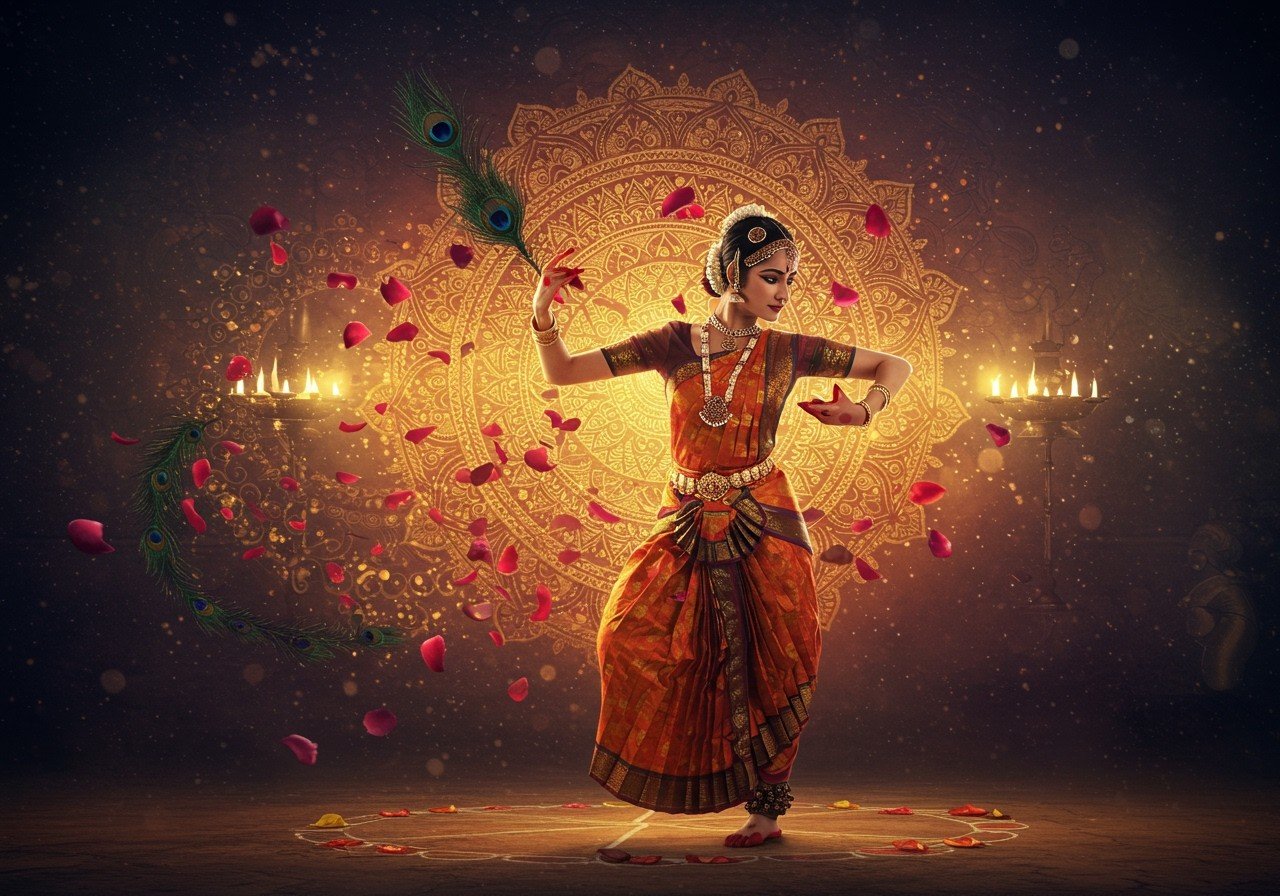
Indian aesthetics are deeply rooted in our culture, philosophy, and art. They shape how we create and appreciate art, literature, and design. Understanding these principles offers a glimpse into how tradition and modernity beautifully intertwine in Indian art and design. Let’s delve into the heart of what makes Indian aesthetics so unique.
Understanding Indian Aesthetics
Indian aesthetics explore the concepts of beauty and taste from a distinctly Indian perspective, encompassing diverse art forms like music, dance, painting, and sculpture. These aesthetics are closely tied to our religious and spiritual beliefs, particularly those of Hinduism, Buddhism, and Jainism. A core concept is ‘Rasa,’ the emotional essence evoked by art. ‘Sringara,’ or beauty, is one of the nine Rasas central to Indian art and culture. This involves ‘Rasa Dhvani,’ where art seeks to evoke specific moods and feelings. Classical texts like the ‘Natya Shastra‘ and discussions on ‘Rasa Theory‘ provide a framework for these aesthetic principles.
Indian Aesthetics: Where Harmony Takes Center Stage
Indian aesthetics are intricately woven with our design principles, reflecting a deep appreciation for spiritual significance, mathematical precision, and natural harmony. This holistic philosophy guides the creation and appreciation of our art, architecture, and design.
Key Principles of Indian Design
- Shilpa Shastra: This ancient canon of architectural design offers comprehensive guidance, from city planning to the delicate proportions of sculptures. It emphasizes the profound connection between human creativity and the cosmic order, incorporating mathematical principles of proportion and scale to achieve perfect harmony. It’s a testament to the precision and balance that Indian aesthetics strive for.
- Vaastu Shastra: This principle focuses on harmonizing architecture with the natural world. It suggests building orientations that optimize natural light, promote airflow, and ensure thermal efficiency. Vaastu emphasizes a continuous dialogue between the built environment and nature, a key aspect of Indian aesthetics.
- Shunyata (Emptiness) and Purnatva (Completeness): These philosophical concepts form the foundation of Indian aesthetics. They highlight the balance between negative space and form, absence and presence, creating a visual rhythm that deeply resonates with the observer. This interplay evokes emotions and fosters a sense of serenity.
- Integration with Nature: Bringing elements of nature into our living spaces reflects Vaastu’s emphasis on aligning architecture with natural forces. This is seen in practices like incorporating courtyards to enhance natural ventilation and light. This integration ensures our art and architecture are alive and connected to the environment.
- Ethical Design: In Indian aesthetics, design carries a moral responsibility. Every element must serve both an aesthetic and symbolic purpose, avoiding anything superfluous. Art is not merely for beauty; it conveys deeper meanings. This ethical approach ensures our creations are thoughtful and meaningful.
- Alignment with Cardinal Directions: Structures are often aligned with the cardinal directions to harness positive energy, particularly with entrances facing east or north, inviting prosperity and well-being. This reflects the integration of spiritual beliefs into Indian aesthetics to create harmonious spaces.
- Space Utilization: Efficient use of space is paramount, avoiding clutter and prioritizing open areas for movement and flow of energy, creating serene and inviting environments. This practicality is balanced with beauty.
- Five Elements Harmony: Balancing the five elements—earth, water, fire, air, and space—within a space is essential. This creates a sense of equilibrium that resonates with the observer, bringing peace and balance to the environment.
- Open Space for Flow: Keeping the center of the home open allows for the free circulation of energy, a principle that promotes tranquility and spiritual well-being, mirroring the focus on balance and flow in Indian aesthetics.
These principles are applied in contemporary design by integrating buildings with cardinal directions, optimizing space for natural light and ventilation, and creating layouts that promote positive energy flow. For a more in-depth understanding of these concepts, you can explore our blog post on Vaastu Shastra.
Poojn.in: Your Guide to Indian Aesthetics
At Poojn.in, we simplify the process of understanding and embracing Indian aesthetic principles in your spiritual practices. We offer authentic pooja items and insightful resources to guide you.
How Poojn.in Enhances Your Spiritual Journey
- Authentic Ritual Items: We provide a comprehensive selection of traditional pooja items crafted from carefully selected materials, adhering to shastraic guidelines. All our products are quality-checked and sourced from verified suppliers, ensuring authenticity and purity.
- Educational Resources: We offer detailed product descriptions explaining their significance, along with blog articles on Indian aesthetics and symbolism. We aim to empower you with knowledge about proper usage and placement of ritual items. For instance, explore our blog post on Hindu scriptures for deeper insights. You can also explore more about Hindu sacred architecture in this informative blog post.
- Specialized Categories: Our website features dedicated sections for murtis and idols showcasing classical designs, traditional textiles and fabrics, and ritual decorative items crafted according to aesthetic principles. Find everything you need for your spiritual practices conveniently categorized for easy browsing.
To further enhance your spiritual experience, we offer a range of related products:
- Brass and copper items (Explore our collection)
- Traditional pooja thalis with authentic designs (Browse our Thalis)
- Decorative diyas and holders (Discover Diyas)
- Classical style pooja accessories (Find Accessories)
Need personalized guidance on selecting aesthetically appropriate items? Our team is happy to help! Reach us via:
- Phone: 03369029784
- WhatsApp: 9476142738
Visit www.poojn.in to discover our complete collection of authentic ritual items that resonate with the beauty of traditional Indian aesthetics.
Celebrating the Timeless Beauty of Indian Aesthetics
Indian aesthetics are a vibrant tapestry of tradition and innovation, seamlessly blending spiritual depth with practical beauty. They guide us in creating art and spaces that are not only visually appealing but also deeply meaningful. By adhering to principles like those found in Shilpa Shastra and Vaastu Shastra, we honor the cosmic order and the natural world. Concepts like Shunyata and Purnatva remind us of the importance of balance, while our ethical approach ensures every creation has a purpose.
The harmony of the five elements and the alignment with cardinal directions infuse our lives with positive energy. Open spaces and efficient use of areas create an environment of peace and tranquility. Indian aesthetics remind us that true beauty lies not just in outward appearance but in the profound connection between our creations and the universe.
As we embrace these timeless principles, we carry forward a legacy of respect for tradition while adapting to modern needs. Indian aesthetics guide us in creating environments of harmony and balance, honoring the wisdom of the past while looking towards the future. For a deeper understanding of how these principles can be applied to festive occasions like Diwali, read our detailed Diwali Puja Guide.
Understanding Core Concepts: FAQs on Indian Aesthetics
What is Indian Aesthetics? Indian Aesthetics encompasses the philosophical and artistic principles that define beauty and art within Indian culture. It embraces various art forms, including music, dance, painting, and literature, with a primary focus on expressing emotions and spiritual experiences.
Why are notes on Indian Aesthetics important? Notes on Indian Aesthetics provide valuable insights for students and enthusiasts seeking to understand the fundamental concepts and theories that underpin Indian art and culture. They illuminate how art forms are created and appreciated within the rich context of Indian tradition.
What topics are covered in the Indian Aesthetics syllabus? A typical Indian Aesthetics syllabus explores topics such as Rasa theory, the significance of aesthetics in classical Indian art forms, the influence of religion and philosophy on art, and the study of important works and artists throughout Indian history.
How does the Rasa theory relate to Indian Aesthetics? Rasa theory is a cornerstone of Indian Aesthetics, explaining how emotions are evoked through art and performance. It identifies nine Rasas, or emotions, such as love, humor, and compassion, which artists strive to express and evoke in their audience.
What role does spirituality play in Indian Aesthetics? Spirituality is integral to Indian Aesthetics. Many Indian art forms have deep connections to religious and philosophical beliefs, aiming to convey spiritual truths and elevate the viewer or listener to a higher state of consciousness.
How do classical Indian dance forms reflect Indian Aesthetics? Classical Indian dance forms, like Bharatanatyam and Kathak, beautifully embody Indian Aesthetics through intricate movements, expressions, and gestures. These dances narrate stories and convey emotions, often drawing inspiration from mythology and spiritual narratives.
Are there modern interpretations of Indian Aesthetics? Absolutely. Modern interpretations of Indian Aesthetics continue to evolve, with contemporary artists blending traditional elements with innovative techniques. They explore themes of identity, modernity, and globalization while staying true to the core principles of Indian Aesthetics.


